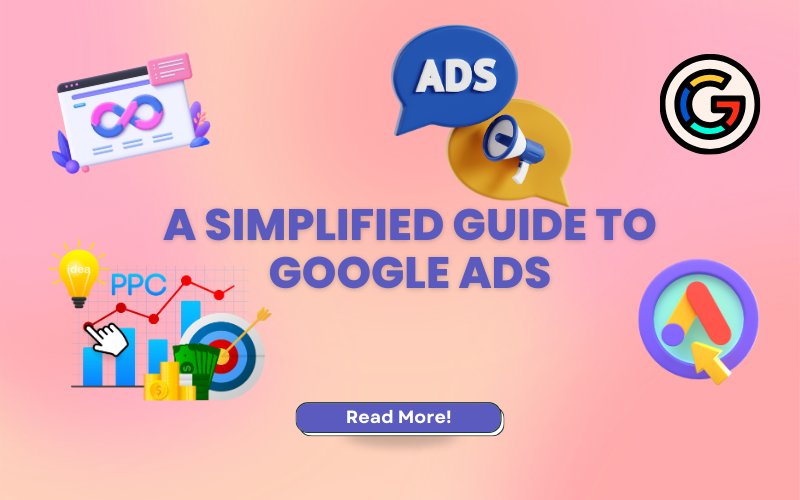
A Simplified guide to Google Ads
If you've ever wondered how to tap into the incredible power of Google Ads for your online ventures. We came up with a simplified guide to Google Ads.
Google Ads, previously known as Google AdWords, is an advertising platform developed by Google. It helps businesses and individuals to showcase their ads on Google's search engine results pages. Also on websites, apps, video platforms and other digital platforms. But how does it work, and why is it crucial for online success?
With Google Ads, advertisers can reach a broad audience. Precisely targeting their ads based on specific keywords, demographics, interests, and other parameters.
What Exactly Are Google Ads?
Google Ads operates on a pay-per-click (PPC) model, where advertisers pay a fee each time someone clicks on their ad. When a user initiates a search for a relevant keyword or visits a website that aligns with the advertiser's criteria. The ad is presented, and the advertiser incurs a charge only when the ad is clicked. These ads can take various forms, including text, display, and video. The ultimate aim is to drive targeted traffic to your website or landing page.
Why Embrace Google Ads?
Instant Visibility:
Google Ads can place your website at the top of search results within moments.
Precision Targeting:
You can reach a specific audience based on keywords, location, and demographics.
Measurable Outcomes:
Google Ads equips you with detailed analytics to monitor your campaign's performance.
Setting Up Your Google Ads Account

Here's a detailed breakdown of the process of creating advertising accounts on Google Ads.
1. Access the Google Ads Website:
Initiate the account creation process by visiting the Google Ads homepage and clicking the "Start" button.
2. Sign In or Create a Google Account:
If you possess a Google Account, sign in using your credentials. Otherwise, select "Create account" to generate a new Google Account.
3. Select Your Advertising Goals:
Google Ads prompts you to specify your primary advertising objective. Which may involve driving website visits, generating leads, or increasing sales. Choose the option aligning with your objectives.
4. Provide Your Website Details:
Input your website's URL to help Google Ads comprehend your business. Enabling it to offer relevant recommendations during the account setup.
5. Define Your Target Location and Language:
Specify the geographic location and the local language preferences of your target audience. This information assists Google Ads in delivering your ads to the appropriate users.
6. Set Up Your First Campaign:
Google Ads offers guidance for configuring your initial campaign. You will need to furnish campaign details, including type, budget, bidding strategy, and ad extensions. Or, you can choose to skip this step and configure your campaign at a later time.
7. Enter Billing Information:
To run ads on Google Ads, you must supply billing details. Including your billing address, payment method, and currency preferences.
8. Review and Submit:
Thoroughly review the information you've entered and make any necessary adjustments. Once you're done, submit your account setup to create your Google Ads account manager.
Setting up a Google Ads campaign can be an overwhelming experience for any new business owner. But worry not! eveIT, an expertised marketing firm will help you step-by-step in setting up a solid Google Ads campaign, customized according to your needs and goals. Click here now to submit your request.
Google Ads Ad Formats
Understanding the various ad formats is important for crafting creative advertisements. Here's an in-depth explanation of commonly used ad formats:
Text Ads
Text ads are straightforward, text-based advertisements that appear on Google search results pages. They comprise a headline, description lines, and a display URL. Text ads prove effective for targeting specific keywords and drive click-throughs to your website.
Display Ads
Display ads are visually captivating advertisements encompassing images or interactive elements. They can be displayed on websites within Google's Display Network, an extensive network of partner sites. Display ads grant greater creative flexibility and can capture the attention of users browsing the web.
Video Ads
Video ads are advertisements visible on platforms like YouTube and other video platforms. They may be skippable or non-skippable. Ranging from brief, 6-second bumper ads to more extensive, immersive video ads. Video ads engage users through attractive visuals and storytelling.
Responsive Search Ads
Responsive search ads empower you to craft ads featuring multiple headlines and descriptions. Google's machine learning algorithms test various combinations of headlines and descriptions. To find out the most effective variations for diverse users and search queries.
Google Shopping Ads
Shopping ads showcase product images, prices, and store information on Google search results pages. They prove ideal for e-commerce businesses. And can elevate the visibility of specific products by driving qualified traffic directly to product pages.
Targeting Precision with Google Ads
Targeting and audience segmentation decides the success of advertising campaigns. They empower you to reach the right audience with highly relevant ads. Here's a comprehensive exploration of targeting and audience segmentation:
Keyword Targeting:
With Google Ads, you can precisely target specific keywords relevant to your business. This strategy makes sure that your ads reach users. Who are actively searching for products or services aligned with your offerings.
Location Targeting:
Location targeting enables you to narrow the reach of your ads to specific geographic locations. Including countries, regions, cities, or even a defined radius around a particular location. This guarantees that your ads are presented to users in the locations you intend to target.
Demographic Targeting:
Google Ads offers options for targeting specific demographics. Such as age, gender, parental status and income. This assists you in refining your targeting based on your target audience's characteristics.
Interest-based Targeting:
Google Ads leverages user browsing behavior and interests. To identify individuals likely to be interested in specific topics or categories. This data can be harnessed to target users based on their demonstrated interests.
Remarketing:
Remarketing in Google Ads enables you to target users who have previously interacted with your website or app. By utilizing a tracking pixel or tag., you can display ads to individuals who have visited specific pages or taken specific actions.
Mastering Keyword Research and Optimization
Keywords are extremely crucial in Google Ads. By selecting relevant keywords and optimizing ads, you can enhance ad performance and effectively reach your target audience. Here's an exploration of keyword research and optimization:
Keyword Research
Identify Campaign Goals:
Begin by understanding your campaign objectives. Are you aiming to drive conversions, increase brand awareness or generate leads? Clear goals will guide your keyword research.
Brainstorm Relevant Keywords:
Create a list of keywords that align with your business, products, or services. Consider the keywords potential clients might use to find what you offer.
Utilize Keyword Research Tools:
Leverage keyword research tools like Google Keyword Planner, SEMrush, or Moz Keyword Explorer. If you want to expand your keywords list and discover new ideas. These tools will provide data on search traffic and keyword competition.
Analyze Competitor Keywords:
Check out the keywords your competitors are using to gain insight. Identify potential keywords you may have overlooked.
Consider Long-tail Keywords:
Long-tail keywords are specific and less competitive phrases. Which often yield higher conversion rates. Using long-tail keywords can help you reach a larger audience.
Refine Keyword List:
Review your keyword list and remove irrelevant or overly broad terms. Focus on keywords closely aligned with your campaign goals and with enough search volume.
Keyword Optimization

1. Match Types:
Google Ads offers different keyword match types – broad match, broad match modifier, phrase match, and exact match. Each match type tells how your ads are triggered by user searches. Experiment with different match types to find the right balance of relevance and reach.
2. Ad Relevance:
Ensure that your keywords align with your ad copy and landing page content. Your ads should effectively convey the value and relevance of your offerings to users searching for those keywords.
3. Ad Extensions:
Take advantage of Ad Extensions in Google Ads. Such as site link extensions, call extensions, or location extensions. Which provide additional information and increase the visibility and Click-Through Rate (CTR) of your ads.
4. Ongoing Optimization:
Continuously monitor keyword performance and make necessary adjustments. Identify underperforming keywords and pause them. Or you can refine their ad copy, bid strategy and landing page experience.
5. Landing Page Optimization:
Ensure your landing pages are optimized for the keywords you target. Landing pages should offer a seamless user experience. By aligning with the search query's intent, and featuring clear calls to action.
Bidding Strategies in Google Ads
In Google Ads, advertisers employ different bidding strategies to compete effectively. Let's explore some common ones:
Cost-Per-Click (CPC)
CPC bidding is like setting a price tag on your products at the marketplace. You pay a predetermined amount each time a user clicks on your ad. It's a straightforward strategy, and you can control your budget effectively.
Cost-Per-Mille (CPM)
CPM bidding focuses on impressions rather than clicks. It's like ensuring that your stall's banner is visible to as many people as possible. You pay based on a thousand impressions, making it suitable for increasing brand visibility.
Cost-Per-Acquisition (CPA)
CPA bidding is akin to ensuring that each person who visits your stall makes a purchase. It optimizes your bids to get the most conversions at your target cost. This strategy is ideal if you're focused on getting tangible results.
Google Ads stands as a dominant and highly effective online advertising platform. The demand for Google Ads work in the freelance marketplace is steadily increasing. As content creators and businesses seek to boost traffic and acquire more leads. Google Ads experts are capitalizing on this trend, earning significant income from the comfort of their homes. The platform's diverse ad formats and advanced features which help advertisers to customize their campaigns. And optimize their ads for superior performance.
Want to read more such informative blogs on marketing? Click here!
Comment
WELCOME
Unlock the potential of Google Ads and achieve instant online success with our step-by-step guide. Learn how to target your audience with precision and gain measurable outcomes.